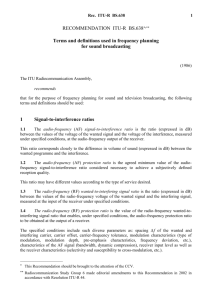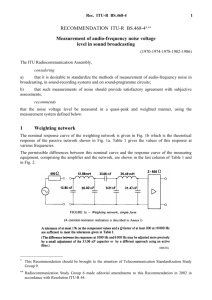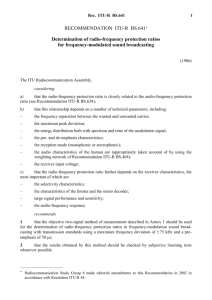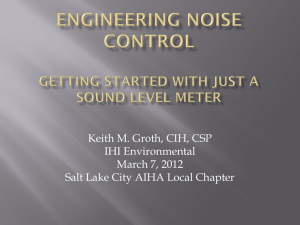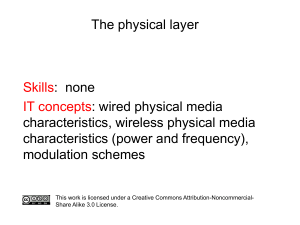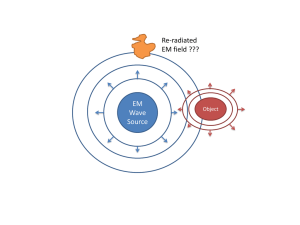RECOMMENDATION ITU-R BS.559-2*,**
advertisement
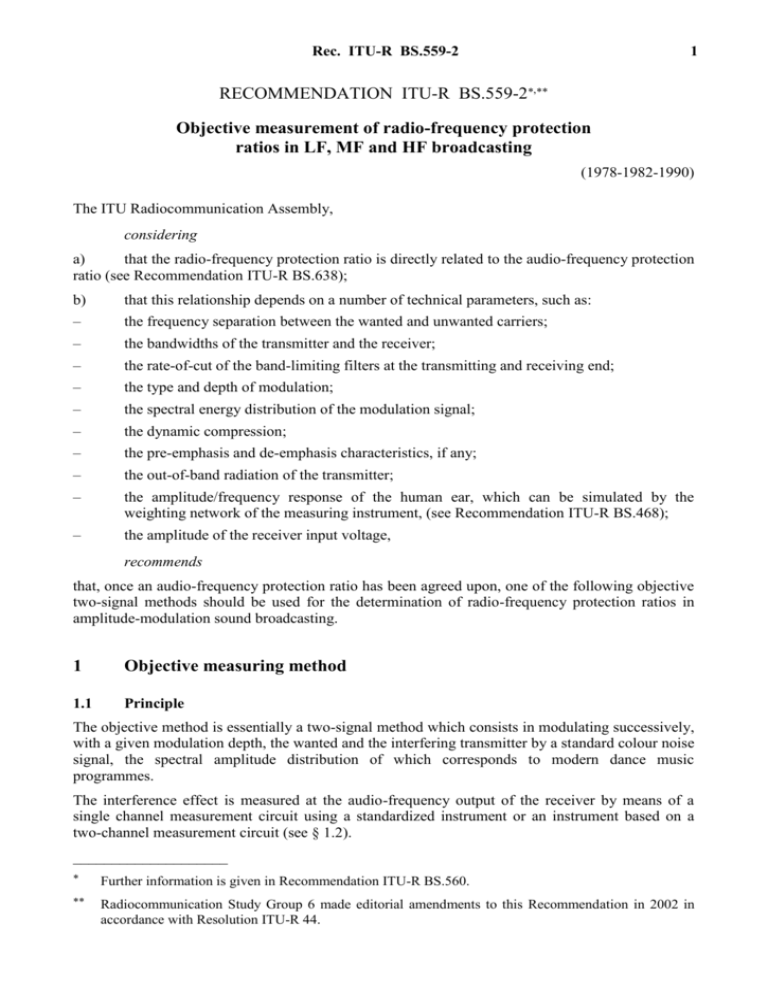
Rec. ITU-R BS.559-2 1 RECOMMENDATION ITU-R BS.559-2*,** Objective measurement of radio-frequency protection ratios in LF, MF and HF broadcasting (1978-1982-1990) The ITU Radiocommunication Assembly, considering a) that the radio-frequency protection ratio is directly related to the audio-frequency protection ratio (see Recommendation ITU-R BS.638); b) that this relationship depends on a number of technical parameters, such as: – the frequency separation between the wanted and unwanted carriers; – the bandwidths of the transmitter and the receiver; – the rate-of-cut of the band-limiting filters at the transmitting and receiving end; – the type and depth of modulation; – the spectral energy distribution of the modulation signal; – the dynamic compression; – the pre-emphasis and de-emphasis characteristics, if any; – the out-of-band radiation of the transmitter; – the amplitude/frequency response of the human ear, which can be simulated by the weighting network of the measuring instrument, (see Recommendation ITU-R BS.468); – the amplitude of the receiver input voltage, recommends that, once an audio-frequency protection ratio has been agreed upon, one of the following objective two-signal methods should be used for the determination of radio-frequency protection ratios in amplitude-modulation sound broadcasting. 1 Objective measuring method 1.1 Principle The objective method is essentially a two-signal method which consists in modulating successively, with a given modulation depth, the wanted and the interfering transmitter by a standard colour noise signal, the spectral amplitude distribution of which corresponds to modern dance music programmes. The interference effect is measured at the audio-frequency output of the receiver by means of a single channel measurement circuit using a standardized instrument or an instrument based on a two-channel measurement circuit (see § 1.2). ____________________ * Further information is given in Recommendation ITU-R BS.560. ** Radiocommunication Study Group 6 made editorial amendments to this Recommendation in 2002 in accordance with Resolution ITU-R 44. 2 1.2 Rec. ITU-R BS.559-2 Output measurement For measuring the wanted and interfering signals at the output of the receiver, use should be made of: – a standardized instrument which should include a network for weighting the subjective interference effect of different interfering frequencies in accordance with Recommendation ITU-R BS.468 and a voltmeter suitable for r.m.s. measurements*; – or a special instrument based on the circuit shown in Fig. 1 and having weighting filters with an amplitude-frequency characteristic as shown in Fig. 2. This instrument has circuits for the separation of narrow-band and wideband interference by means of retunable band and rejection filters respectively, circuits for weighting each of these types of interference with maxima in the region of 4 kHz, and 0.5 kHz and 3.0 kHz respectively, an adder and an r.m.s. voltmeter. 1.3 Noise signal for modulating the signal generators Two conditions must be fulfilled by the standardized signal to simulate programme modulation: – its spectral constitution must correspond to that of a representative broadcast programme; – its dynamic range must be so small as to result in a constant unequivocal reading on the instrument. The amplitude distribution of modern dance music was taken as a basis, as it is a type of programme with a considerable proportion of high audio-frequencies, which occur most frequently. However, the dynamic range of this type of programme is too wide and does not fulfil, therefore, the second requirement mentioned above. A signal which is appropriate for this purpose is a standardized coloured noise signal, the spectral amplitude distribution of which is fairly close to that of modern dance music (see curve A of Fig. 3, which is measured using one-third octave filters).** This standardized coloured noise signal may be obtained from a “white-noise” generator by means of a passive filter circuit as shown in Fig. 4. The frequency-response characteristic of this filter is reproduced as curve B of Fig. 3. (It should be noted that the difference between curves A and B of Fig. 3 is due to the fact that curve A is based on measurements with “one-third octave” filters which pass greater amounts of energy as the bandwidth of the filter increases with frequency. The spectrum beyond the required bandwidth of the standardized coloured noise should be restricted by a low-pass filter having a cut-off frequency and a slope such that the bandwidth of the modulating signal is approximately equal to half the standardized bandwidth of emission. The audio-frequency amplitude/frequency characteristic of the modulating stage of the signal generator shall not vary by more than 2 dB up to the cut-off frequency of the low-pass filter. ____________________ * The use of an r.m.s. rather than a quasi-peak meter as given in Recommendation ITU-R BS.468 permits more accurate account to be taken of the beat-note predominant with closer frequency spacings and all other effects. This conclusion was drawn from the excellent agreement between the values of radiofrequency protection ratio obtained, either using the objective two-signal method, or from subjective listening tests for all values of frequency spacing. ** ITU-T Recommendation J.19 proposes a different coloured noise signal. The use of that signal instead of the one proposed in this Recommendation would lead to different relative values of the radiofrequency protection ratio which would only be justified if the characteristics of a typical programme signal would better be simulated by the coloured noise of ITU-T Recommendation J.19. Rec. ITU-R BS.559-2 3 D01-sc 4 Rec. ITU-R BS.559-2 D02-sc D03-sc Rec. ITU-R BS.559-2 1.4 5 Measuring arrangements Figure 5 shows a schematic diagram of the measuring arrangements, in which the elements of fundamental importance are drawn in thick outlines. The other elements are measuring and control devices which are required for putting the investigations into practice, or for facilitating them. 0559-05 1.5 Depth of modulation of the test transmitters The depth of modulation of the wanted or interfering signals is determined by the following procedure. The signal generator is first modulated to a depth of 50% with a sinusoidal tone at 1 kHz from the generator A, adjusted by means of the attenuator B and verified by oscilloscope S at the radio-frequency outputs of modulators H or L, and the required audio-frequency voltage is measured at the modulator inputs (switch U) by means of the instrument R. The amplitude of the noise signal (C D), which is measured with the same measuring instrument R, should then be adjusted (by means of the attenuator E) to read 6 dB lower than the value obtained with the sinusoidal signal; provided that the instrument has a time constant of 200 ms. This corresponds to a depth of modulation of 50% measured with a programme meter with quasi-peak indication. Deeper modulation is not appropriate, because, on account of its very small dynamic range, the noise would have a more disturbing effect than any real programme. 6 1.6 Rec. ITU-R BS.559-2 Audio-frequency signal-to-interference ratio The signal generator (wanted signal) (G H J) modulated with noise according to § 1.3 and 1.5 produces a signal at the audio-frequency output of the receiver under test Q, which represents, measured with the instrument R, the reference level “zero”. The noise modulation is then transferred by means of the switch U, from the audio-frequency input of the modulator H of the signal generator (wanted signal) to the audio-frequency input of the modulator L of the signal generator (interfering signal). After suppression of the modulation of the wanted signal, the radiofrequency level of the interfering signal generator (K L M) is then adjusted so that the unwanted voltage, as measured by means of the instrument R at the receiver output, results in the required audio-frequency signal-to-interference ratio; for example, 20, 30 or 40 dB below the reference value. 1.7 The radio-frequency level of the wanted signal at the receiver input The radio-frequency output voltage of the wanted-signal generator (G H J) should be, to begin with, as small as possible, so that only linear receiver characteristics enter into the measurement. The level of the unmodulated signal generator should, however, be chosen high enough for the noise voltage (mostly the inherent noise of the receiver), measured at the audio-frequency output of the receiver, to lie at least 3 dB below the noise voltage in the presence of the modulated interfering signal according to § 1.6. The radio-frequency output of the signal generator (G H J) should then be increased in steps to include the non-linear characteristics of the receiver (crossmodulation). 1.8 Influence of non-linear distortion in the signal generators The non-linear distortion occurring during the modulation process in the signal generator has components which widen the radio-frequency spectrum and thus give rise to increased radiofrequency wanted-to-interfering signal ratios in the region of the adjacent channel and the adjacentchannel but one. The non-linear distortion in the signal generators should not, therefore, exceed 1% to 2%. 1.9 Accuracy The results obtained with the objective method have been compared with the results of corresponding subjective tests. From these tests, it has been found that objective measurements give a first approximation to those obtained with the subjective method. In cases where the wanted programme is particularly susceptible to interference (e.g. speech with long pauses) the difference between the objective measurements and the subjective tests may amount to more than 5 dB. The results of protection ratio measurements depend to a considerable extent on the receiver passband. For measurements or calculations by the single-channel method, the error in protection ratio measurements A versus frequency difference f for two receiver passband values on the intermediate frequency 2 f 9 kHz and 2 f 5 kHz (at –6 dB) is shown in Fig. 6. 2 Numerical method 2.1 Principle To determine the relative radio-frequency protection ratio, the physical processes underlying the objective methods, viz., the determination of the weighted noise power by single- or two-channel methods (see § 1.2), are simulated by means of a mathematical model. Rec. ITU-R BS.559-2 7 D05-sc Two channels with the carrier frequencies fT and fR, whose frequency difference is f are assumed. The transmitter power density spectrum related to the incremental bandwidth Beff is simulated by the function FT depending on the relative frequency | f |. This function is formed by multiplicative sub-functions (e.g. attenuation, spectral energy distribution, pre-emphasis of the higher audiofrequencies) and additive sub-functions (e.g. out-of-band radiation) or it is built up by polygonal traces. In a similar way, the overall response of the receiver, including weighting of the noise power with the aid of single-channel or two-channel methods, was represented by means of the function FR or FR1 and FR2, respectively, depending on the relative frequency | f – f |. In double-sideband modulation, FT and FR are symmetrical with respect to the respective carrier frequencies. Figure 7 shows the fundamental shape of the functions FT and FR, the most important sub-functions as well as the meaning of the designations used. The transmitter power density spectrum with the carrier frequency fT produces an interference power PT in the received channel with the carrier frequency fR, which, at a given frequency difference f, can be calculated by integrating the product FT FR. As a result, one obtains: Error! (1) 8 Rec. ITU-R BS.559-2 D06-sc Rec. ITU-R BS.559-2 9 When performing the integration according to (1), however, for f 0 (receiver exactly tuned to the transmitter frequency), one obtains the useful receiver power PN. The relative radio-frequency protection ratio Arel is the ratio of interference power to useful power, in the channel under consideration. Arel 10 log ( PT / PN ) dB (2) With the aid of the numerical method it is also possible to determine separately the interference components caused by the carrier beat and by the sidebands. It is expedient to carry out the integration according to (1) with the aid of computers and numerical integration methods. In practice, most problems can satisfactorily be solved with an incremental bandwidth of Beff 100 Hz by numerical integration. Since the method described is based on the determination of power, it does not provide the additional noise suppression by 3 dB found during measurements of the co-channel interference performed on systems with envelope detection. The relative radio-frequency protection ratios obtained with the numerical method must therefore be corrected by –3 dB. A simplified version of this method was developed in France. In principle, the method only takes account of the frequency f which mainly contributes to the integral of equation (1). Thus the protection ratio can be determined in a graphic way using representative curves of the functions FT and FR. The method is entitled “the graphical method”. 2.2 Accuracy and limits of the method The results obtained for a double-sideband system are shown in Fig. 8 in comparison with measurement results. As long as the values of the relative radio-frequency protection ratio do not go beyond – 40 dB, the deviations between calculation and measurement, amount to about 1 dB. Beyond – 40 dB the measurements are increasingly affected by unavoidable noise inherent to the equipment used and by the intermodulation distortion in the receiver, which can no longer be neglected. These factors are not taken into account in the calculation. The graphical method is, in general, appropriate for estimating protection ratio values, provided the interference is mainly determined by a rather limited part of the interfering signal spectrum. The differences in such values, when compared with those derived from objective measurements do not exceed 3 dB. NOTE – The measuring method is more accurate than the graphical or numerical methods, since all technical parameters are more exactly taken into account. The graphical and the numerical methods, however, have the essential advantage of permitting the immediate determination of the radio-frequency protection ratio values for any receiver, existing or projected. By means of a single computer programme, the numerical method can be executed in a fraction of the time needed to make objective measurements. The numerical method is, therefore, suitable for the optimization of the technical parameters of any amplitude-modulation transmission system for sound broadcasting in bands 5 (LF) and 6 (MF) and, with only a few minor modifications, for single-sideband systems also. 10 Rec. ITU-R BS.559-2 D07-sc
